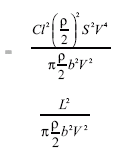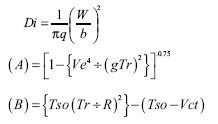Crossref Citations
This article has been cited by the following publications. This list is generated based on data provided by Crossref.
Huyssen, R. J.
Mathews, E. H.
Liebenberg, L.
and
Spedding, G. R.
2016.
On the wing density and the inflation factor of aircraft.
The Aeronautical Journal,
Vol. 120,
Issue. 1224,
p.
291.


 and in level flight L is substantially equal to the W.
Therefore:
and in level flight L is substantially equal to the W.
Therefore:  Sequence of evaluation for relating the straight glide performance (Vd/Ve) curve of a sailplane to the achievable Vct in a particular thermal.
Sequence of evaluation for relating the straight glide performance (Vd/Ve) curve of a sailplane to the achievable Vct in a particular thermal.
